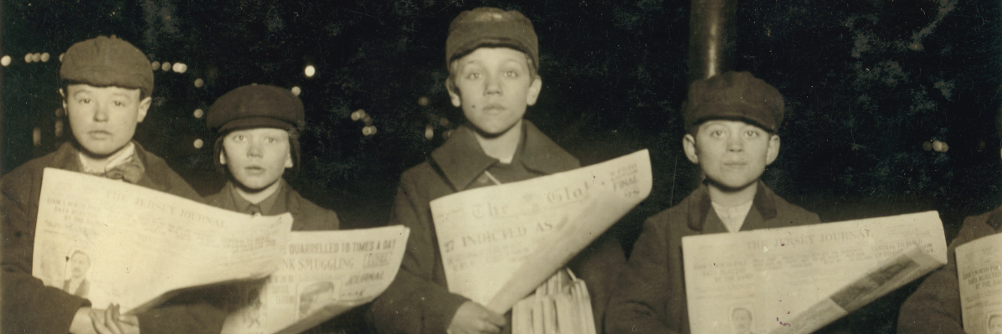Scopri ed esplora la memoria storica e il patrimonio del mondo
Globalmente – Nationale – Regionale
MediaStorici è un portale inerntationale d’accesso a media digitalizzate originariamente analogiche di tutti i tipi con focus su notizie, fotografia e poster. La piattaforma si collega alle raccolte e ai titoli di stampa di archivi, società di media e agenzie.
- Stampa e reviste, fogografia, manifesti, film/televisione/video e radio.
- Collezioni e titoli dei media di archivi, biblioteche, musei e altre istituzioni di memoria, nonché di società e agenzie di media.
- Aiuta a cercare e utilizzare le offerte.
- Informazioni su collezioni disponibili e titoli di stampa, istituzioni da offrire e società di media.
Il blog di MediaStorici offre articoli su piattaforme e collezioni, su la storia dei media e su una vasta gamma di argomenti storici.
Titoli di stampa dall’avvento dei primi giornali intorno al 1605 in Europa. Quotidiani e settimanali, riviste di riviste del XIX e XX secolo, riviste politiche e culturali selezionate con contenuti sociali e storici.
MANIFESTO
Manifesti dalla metà del XIX secolo ad oggi: manifesti artistici e politici, cartelloni pubblicitari per tutti i settori, dal turismo al cibo, prodotti di bellezza e moda, trasporti, teatro e cinema.
FOTOGRAFIA
La fotografia nella sua varietà tecnica e motivazionale dall’avvento del medium intorno al 1839: fotografia di paesaggio, fotografia di reportage, fotografia d’arte, architettura, fotografia di moda e materiale, fotografia di nudo e ritratto e fotografia amatoriale.
FILM/TELEVISIONE
Formati di notizie e film documentari: le prime notizie dal 1895, i cinegiornali dal 1908, i notiziari televisivi, le riviste di notizie, i film documentari, i documenti video, i video privati e quelli domestici.
RADIO/AUDIO
Trasmissione di notizie e informazioni sin dal suo inizio negli Stati Uniti negli anni ’20: notizie, riviste politiche, rapporti documentari, programmi su argomenti storici e culturali.
ARTICOLI DI BLOG
Articoli su storia dei media, storia e collezioni o piattaforme. Ciascuno collegato alle fonti utilizzate. Completamente equipaggiato con fascicoli dettagliati di elenchi di collegamenti annotati.
ARTICOLI DEL BLOG PIÙ RECENTI
IL MONDO DI IERI NEGLI CINEGIORNALI
- I cinegiornali sono stati il primo formato di notizie cinematografiche. Erano dal 1908 in Francia, presto mostrati in tutto il mondo come un’aggiunta nei cinema. Nonostante la concorrenza della televisione dopo la seconda guerra mondiale, il cinegiornale rimase in molti paesi fino agli anni ’70 e ’80.
- MediaStorici guarda indietro su eventi significativi e interessanti che hanno visto cinegiornali in tutto il mondo. Piccole spiegazioni situano le registrazioni in un contesto storico.
- I report collegati provengono da raccolte online di archivi pubblici, società di comunicazione e altri fornitori commerciali.
- Qui troverai tutto REVISIONE DI CINEGIORNALE
Marian Anderson’s legendary easter concert at the Lincoln Memorial
Easter Sunday, April 9, 1939. 75’000 visitors come to Marian Anderson’s recital at the Lincoln Memorial. The memorable event makes the contralto a symbol of the demand for equal rights for all US citizens.
- Marian Anderson’s Easter Sunday Lincoln Memorial Concert
- April 9, 1939
- UCLA Film & Television Archive
- Copyright UCLA
Never before has there been an event of this size at this location. Millions of people are following the event on the radio. Marian Anderson begins her recital with “My Country, ‘This of Thee”. Through her interpretation, the patriotic hymn becomes unequivocally an appeal that freedom and the constitution have to apply to all Americans, regardless of skin color.Marian Andersen (1897-1993) grows up in humble circumstances in Philadelphia. Her talent as a singer already shows as a girl in the church choir. After first successes, she continues her musical education in Europe. In the thirties, she performs in many of Europe’s renowned concert halls where she thrills the audience. Back in the USA, she becomes also here a star. Her broad repertoire includes aria and leader recitals as well as spirituals. A highlight of her career is in 1955 her appearance at the Metropolitan Opera. In the 1950s, she becomes an icon of the Civil Rights Movement. © ff December 2018
Tragic Alpine disaster – “white death” claims immense toll of death
In the winter of 1950/51, the worst avalanche disasters of the 20th century cause immense suffering and destruction in many villages in the Alps. More than 270 people are killed by masses of snow and debris that are hitting villages and traffic routes.
- Cinegiornale svizzero:
- Slavine micidiali. Nr. 463, 27.01.1951
- Valanghe nel Ticino. Nr. 466, 16.02.1951
- Copyright: Cinémathèque Suisse/Swiss National Library
- Platform: MEMOBASE
In Switzerland, disasters caused by the forces of nature occur in two waves. Between the 19th and 21st of January, in the cantons of Grisons, Valais, Uri and Glarus, innumerable avalanches crash down on from the mountains. Swiss Newsreel covers the event in a special edition (Video 1). The devastating effects are worst in the village of Vals in the canton of Grisons. On the night of January 20, just before 10 pm, avalanches hit several houses. 19 people, including 8 children, die in the debris and snow. In Andermatt, canton of Uri, 13 people get killed.
On February 11th and 12th, 1951, Switzerland again suffers disastrous avalanches, this time in the southern canton of Ticino. In some valleys, over 4 meters of fresh snow have fallen within 10 days (Video 2). Avalanches bury the Gotthard Railway over long distances. Once again, the “the winter of avalanches” takes a heavy toll: 16 people are recovered dead, including 10 in the village of Airolo alone, where an avalanche destroys an entire quarter.
The avalanche disaster in the Alps gets worldwide attention in the media. The legendary US magazine Life publishes 8 pages on the event (p. 19-25). © ff December 2018



